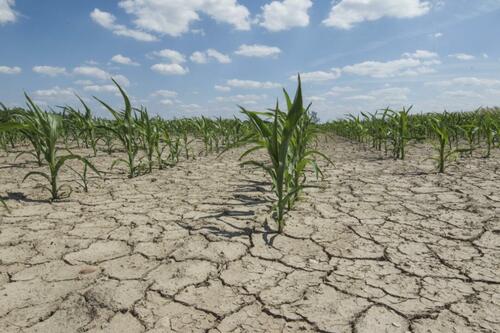‘Intense Heat And Dry Conditions’ Threatening US Crops, Herds
At perhaps the worst possible time, scorching heat and dry conditions are jeopardizing US agriculture – threatening soybeans, corn and other crops.
According to the Wall Street Journal, intense heat over the past week has put large portions of the United States – particularly the South and West – at risk during an important period during the Midwest crop-growing season.
In parts of Kansas, Oklahoma, Texas and other states, the heat is exacerbating longer-running drought conditions – putting immense stress on livestock and parching pastures, and forcing ranchers to spend more on supplemental feed for cattle.
In Iowa, which produces more corn than any other U.S. state, temperatures are forecast to hit 100 degrees in the western part of the state, according to the National Weather Service. Major livestock-producing states, including Texas and Oklahoma, are expected to see temperatures hit 104 degrees over the weekend. Some places in the region have had extremely hot and dry weather for prolonged periods. -WSJ
Oklahoma cattle rancher Charlie Swanson says temps have exceeded 100 degrees every day this month, including a 114-degree scorcher on Tuesday. When combined with virtually no rain, the heat is ‘roasting his pastures’ – and killing the grass and forage he grows for his cattle to graze on.
The high temps come as Oklahoma ranchers were already paying more for feed, fertilizer, fuel and other costs. Swanson’s feed costs have climbed by roughly $100 per ton vs. last year, while fertilizer is also more expensive. He recently sold 80 cows to a beef packer in Texas because he couldn’t afford to keep feeding them.
“Everybody is cutting back on expenses if they can,” said Swanson.
The prices that ranchers receive for their cattle have climbed roughly 15% from a year ago, according to the USDA, but producers are still struggling to break even. Prices for hay, which is widely used to feed cattle, were 56% higher in April than in 2021, according to a June report from the Federal Reserve Bank of Kansas City. Cattle producers are estimated to have lost money the past two months, according to a cost-and-return analysis from Iowa State University. -WSJ
Where there’s trouble, opportunity arises.
Helping cattle ranchers cope with the situation is Panorama Organic Grass-Fed Meats, a division of poultry company Perdue Farms Inc., which helps ranchers in drought-stricken states connect with buyers in states that are doing ok. “For example, the company might connect a rancher in Bakersfield, Calif., who is struggling with dry weather with a producer in Nebraska looking to buy cattle.”
“We’re the matchmaker,” said Kay Cornelius, Panorama’s general manager.
According to industry analysts, if the heat persists across the country and this year’s corn crop can’t handle it, feed costs will march even higher, driving up input costs for livestock producers.
Eddie Sanders, a fourth-generation corn grower in Franklin, Tenn., said he expects to harvest only roughly one-third to one-half of his corn crop this year, because of the hot and dry weather. He said he is hoping to be able to salvage his soybean crop, but if the hot weather persists into August, that too might be at risk.
“We’re burned up here,” he said. “We’re at the mercy of a rain every 10 days.” -WSJ
And thanks to a wet spring, many Midwestern farmers got a late start planting corn and other crops. Now, it’s too dry to sustain their growth in many regions. According to the US Drought Monitor, almost 30% of US corn production and 26% of soybean production are in areas experiencing drought. As the Journal notes: “Corn is now pollinating in many parts of the grain belt, a time when the plants require the most water. Serious drought and heat stress during corn pollination can translate to yield losses of about 9% a day, said Dan Quinn, an agronomist at Purdue University and corn specialist who works with regional farmers.”
What’s doing well right now?
Parts of Illinois, Indiana and Iowa which have received rain recently, while the USDA’s July 18 report showed steady corn conditions – and corn futures at the Chicago Board of Trade have fallen around 7% over the past week. What’s more, rain has been forecast for parts of the Midwest, which should ease some crop concerns.
According to Rick Dusek, head of country operations at Minnesota-based farmer cooperative CHS Inc., “Right now there are a lot of eyes watching North American production.”
Tyler Durden
Sat, 07/23/2022 – 18:00

